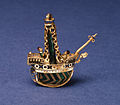
A pomander, from French pomme d'ambre, i.e., apple of amber, is a ball made for perfumes, such as ambergris (hence the name), musk, or civet. [1] The pomander was worn or carried in a case as a protection against infection in times of pestilence or merely as a useful article to mask bad smells. [1] The globular cases which contained the pomanders were hung from a neck-chain or belt or attached to the girdle, and were usually perforated in a variety of openwork techniques and made of gold or silver. [1] Sometimes they contained several partitions, in each of which was placed a different perfume. [1]
Contents
- History
- Medieval
- Renaissance
- Modern
- Ingredients
- Culture
- Etymology
- Gallery
- See also
- References
- Sources
- External links
The term "pomander" can refer to the scented material itself or to the container that contains such material. [2] [3] [4] The container could be made of gold, silver or other materials and eventually evolved to be shaped like nuts, skulls, hearts, books, and ships. Smaller versions were made to be attached by a chain to a finger ring and held in the hand. Even smaller versions served as cape buttons or rosary beads. [5]
A pomander can be a bag containing fragrant herbs and might be viewed as an early form of aromatherapy. Pomanders can be considered related to censers, in which aromatics are burned or roasted rather than naturally evaporated.








